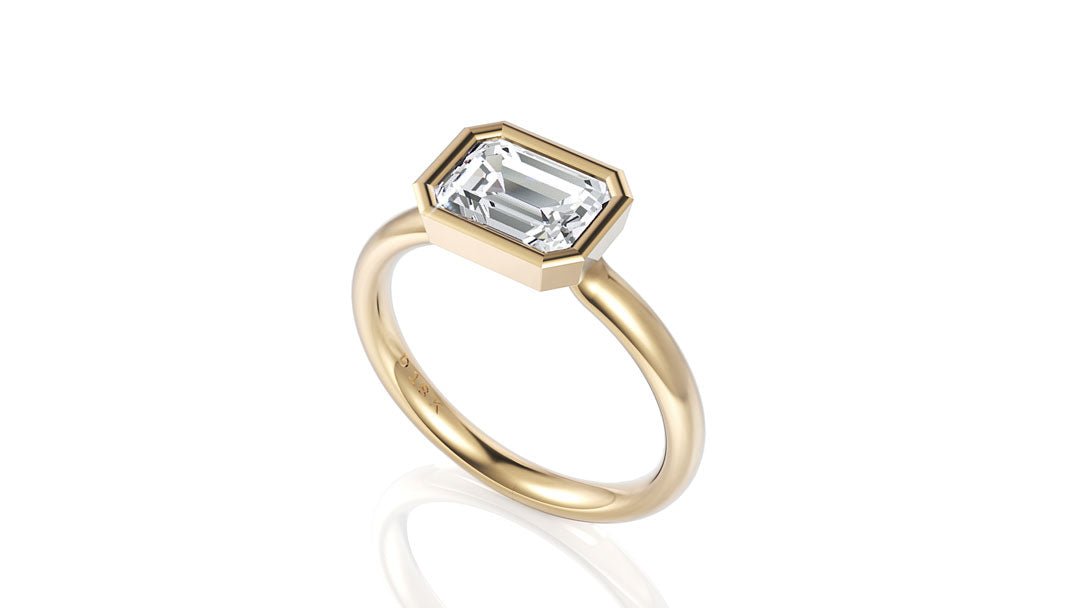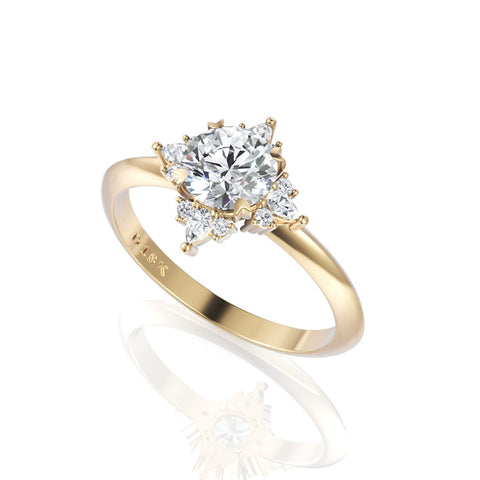
Natural Diamonds vs Lab Grown Diamonds: How to Choose
When deciding between natural and lab-grown diamonds, consider your budget and each type's unique properties and origins. Natural diamonds, formed over billions of years, carry a rich geological history, but their mining can impact the environment. Lab-grown diamonds, more affordable and ethically sourced, have identical physical, chemical, and optical properties. Both types can meet top-quality standards, and your choice may hinge on personal values and diamond symbolism. By exploring each aspect more closely, you'll understand what you're investing in and make an informed decision when buying an engagement ring.
Key Takeaways
- Determine your budget. Lab-grown diamonds offer larger sizes or better quality at lower costs than natural diamonds.
- Consider your values and ethics; lab-grown diamonds have a lower environmental impact and ensure fair labor practices.
- Evaluate the diamond's quality and value using the GIA grading system, considering the 4Cs: carat, color, clarity, and cut.
- Reflect on the symbolic meaning; natural diamonds carry a geological narrative due to their formation process, while lab-grown diamonds are flawless.
- Consider the diamond industry's environmental impact and ethical concerns; choose ethically sourced natural or lab-grown diamonds.
Understanding Natural Diamonds
Let's explore the fascinating world of natural diamonds formed billions of years deep within the Earth's mantle. These sparkling gems begin life as raw carbon, subjected to intense heat and pressure over 1-3 billion years. This complex diamond formation process results in unique stones that are as beautiful as they are tough.
You're probably wondering how these hidden treasures get to the surface. That's where diamond mining comes in. These precious gems journey from deep within the earth to the surface through volcanic eruptions. The magma, or molten rock, carries the diamonds and cools to form kimberlite pipes, the primary sources of diamond mining.
As you can imagine, mining these stones is a challenging task. It's an intricate process involving careful extraction and screening to ensure the diamonds aren't damaged. Once mined, they're cut, polished, and prepared for the market.
Each natural diamond you see in a jewelry store has a long and fascinating journey behind it. A journey that begins with the formation deep in the earth's mantle and ends with meticulous mining and preparation.
The Process of Lab-Grown Diamonds
Now, considering the following about lab-grown diamonds, you might be surprised to learn that these gems mirror their natural counterparts in nearly every way, all thanks to modern technology. This tech-driven diamond formation is a marvel to behold.
Two methods are primarily used in the creation of these precious stones. High Pressure-High Temperature (HPHT) mimics the natural process, applying extreme heat and pressure to carbon until it crystallizes into a diamond. Chemical Vapor Deposition (CVD), on the other hand, starts with a diamond seed placed in a sealed chamber, where it's exposed to a carbon-rich gas and high temperatures, leading to the growth of a diamond layer by layer.
Technological advancements have made it possible to replicate the conditions necessary for diamond formation in a controlled environment. This means you can have a diamond that's physically, chemically, and optically identical to a mined one sans the years-long formation process and potential ethical concerns. Remember that while they share many similarities, lab-grown and natural diamonds aren't completely identical. This distinction is something we'll explore further in the next section.
Key Differences Between Both Types
While lab-grown and natural diamonds might appear identical to the untrained eye, key differences set them apart. The most significant difference lies within their diamond formation. Natural diamonds are formed billions of years deep within the Earth's mantle under high pressure and temperature conditions. They're then brought to the surface through volcanic eruptions, adding to their geological importance.
On the other hand, lab-grown diamonds are created in a controlled environment within weeks, using high-pressure, high-temperature (HPHT), or chemical vapor deposition (CVD) methods. These processes mimic the natural conditions but on an accelerated timeframe.
Further, natural diamonds have an undeniable charm and romanticism due to their geological importance. Their formation tells a story of our earth's history, making each stone unique. Lab-grown diamonds, while identical regarding physical, chemical, and optical properties, lack this geological narrative.
Also, natural diamonds often contain inclusions or blemishes formed during their journey to the surface. Lab-grown diamonds, however, are more likely to be flawless due to the controlled conditions of their creation.
Evaluating the Quality and Value
When evaluating the quality and value of natural and lab-grown diamonds, you must consider factors such as the stone's carat weight, color, clarity, and cut, also known as the 4Cs.
Understanding grading systems is another essential aspect. Natural diamonds are primarily evaluated using the Gemological Institute of America (GIA) grading system. This system considers the 4Cs and provides a detailed analysis of the stone's quality. Lab-grown diamonds can also be assessed under this system, ensuring they adhere to high-quality standards.
Yet, remember that size doesn't necessarily dictate value. You might find a larger lab-grown diamond that's more affordable than a smaller natural one. This difference stems from the scarcity of natural diamonds and the cost of their extraction.
For both types, diamond care is important in maintaining their value. Regular cleaning, avoiding harsh chemicals, and storing them properly can help preserve their brilliance and worth. A diamond's durability doesn't exempt it from potential damage or wear over time.
Ethical Considerations to Keep in Mind
When it comes to diamond sourcing, it's essential to contemplate the ethical implications of your decision between natural and lab-grown options. You must consider the practices involved in obtaining these precious gems.
Sustainable mining is a crucial point to remember. Natural diamond mining can cause environmental degradation, posing threats to local ecosystems. On the other hand, lab-grown diamonds have a lower environmental impact. They're created in controlled settings, minimizing harm to the environment.
You should also think about fair trade practices. The diamond industry has a dark history of conflict and exploitation. Choosing a diamond sourced through fair trade practices ensures that miners receive fair compensation and work under humane conditions. While natural diamonds can be sourced ethically, it's often more challenging to guarantee these standards are met.
Conversely, lab-grown diamonds don't carry the same ethical baggage. The creation process is transparent, and workers' rights are easily ensured.
Deciding Based on Your Budget
So, remember how your budget factors into the choice between natural and lab-grown diamonds. The answer lies in a straightforward price comparison. On average, lab-grown diamonds cost about 30% less than natural diamonds of similar size and quality. This price gap may widen or narrow depending on the specific parameters of the diamond you're considering.
The affordability factor must be considered. If you're on a tight budget, a lab-grown diamond could offer you the chance to buy a larger or better quality diamond for the same price as a smaller or lesser quality natural diamond. This means you can get more sparkle for your buck, making lab-grown diamonds a compelling option for budget-conscious shoppers.
However, consider that a diamond's value isn't solely determined by its price. Other factors, such as its sentimental value, origin, and rarity, also come into play. Ultimately, whether you opt for a natural or lab-grown diamond should depend on your budget and what you value most in a diamond. So, weigh your options carefully and choose wisely.
Making the Final Choice
Given all these factors, making the final choice between a natural and lab-grown diamond can be a complex decision, but it should ultimately align with your personal values and budget constraints.
It's essential to take into account your personal preferences. Do you value the rarity and unique imperfections of a natural diamond? Or do you prefer the flawless precision and modernity of a lab-grown diamond?
Consider the environmental impact as well. Natural diamonds can have significant ecological consequences, while lab-grown diamonds typically have a smaller carbon footprint. However, it's worth mentioning that not all lab-grown diamonds are created equal – some processes are more eco-friendly than others.
The final choice is yours. You need to be happy with your decision. Whether you choose a natural diamond for its unparalleled beauty and symbolism or a lab-grown diamond for its ethical and budget-friendly appeal, make sure it reflects your values, satisfies your preferences, and fits within your budget.
Frequently Asked Questions
What Are the Common Misconceptions About Lab-Grown Diamonds?
You might think lab-grown diamonds lack the durability of natural ones, but that's not true. They're equally hard. Another misconception is they need to be more eco-friendly, yet their sustainability impact is much lower than mined diamonds.
Can Lab-Grown Diamonds Be Insured Just Like Natural Diamonds?
You can insure lab-grown diamonds just like natural ones. Despite misconceptions, lab-grown durability and diamond authenticity aren't compromised. They're real diamonds, and insurance companies recognize that, providing similar coverage options.
How to Clean and Maintain Lab-Grown Diamonds?
You clean and maintain lab-grown diamonds just like natural ones. Use mild soap, warm water, and a soft brush. Diamond durability isn't a concern. Synthetic diamond ethics aren't affected by your cleaning methods either.
Do Lab-Grown Diamonds Have the Same Spiritual Properties as Natural Ones?
You're questioning if lab-grown diamonds share the same spiritual significance as natural ones. It's subjective. Some believe energy comparison differs, while others feel they're identical. Ultimately, it's your personal belief that determines the spiritual value.
What Is the Resale Value of Lab-Grown Diamonds Versus Natural Diamonds?
You're asking about the resale value of lab-growns compared to natural diamonds. It's generally lower because pricing factors like market demand favor natural diamonds. However, it's worth researching to get the current market rates.
Conclusion
So, it's your call. Natural diamonds, with their billions of years of history, or lab-grown diamonds, are identical in structure and more eco-friendly. Keep quality, ethics, and budget in mind.
Remember, a diamond's value isn't just its price tag but the joy and meaning it brings. Whichever you choose, make sure it reflects your unique story and love.
After all, it's not where the diamond comes from that matters most, but where it's going.
